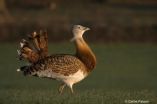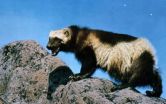(Press-News.org) Up until now it was unknown whether males of the great bustard (Otis tarda), an emblematic bird in Spain and endangered at a global level, transmit information on their weight, size, and age through their plumage. For the first time a study shows that the 'beards' and the design of the neck are "reliable" indicators of the weight and age of their bearers, and are used to both avoid fights with competitors and to attract females.
"The heaviest males (best physical condition) make it known to other males through the length and number of 'beards', and thereby avoid bloody fights to ascend in rank which would occur if these signals did not exist", Juan Carlos Alonso, main author and researcher in the Spanish National Museum of Natural Sciences (CSIC) informs SINC.
The study, which has been published in Ethology, shows for the first time that great bustard (Otis tarda) males achieve greater reproductive success and avoid "dangerous" and "unnecessary" confrontations due to the extent of development of their plumage. "Despite all this, sporadic fights do occur which lead to, on some occasions, the death of one of the contenders", says Alonso.
According to the scientist, when they are being chosen by the females, the oldest males "can compensate for a certain deficit in weight with greater experience thanks to their more advanced age".
Over a period of ten years, the researchers analysed wild specimens which were marked with transmitters to monitor the evolution over time of the colouring of their neck, and of the quantity and length of the 'beards' (feathers on both sides of the beak). The team verified that the changes in the plumage of the males were linked to changes in their reproductive success.
In the past, "bearded bustards" were hunted for being old and for trophies, a practice which "probably contributed to eliminating many of the most successful specimens, rather than eliminating the senescent ones which do not reproduce", points out the biologist, who adds that this selective hunting could alter the demographic balance of populations.
The sexual dimorphism of bustards
60% of great bustard specimens, an emblematic bird of the Iberian fauna which is endangered at a global level, live in Spain. Their significant sexual dimorphism (difference in size between males and females), "the greatest in all birds and one of the highest amongst vertebrates", is the result of strong sexual selection, which forces the males to compete each year to ascend in the group's hierarchical ladder.
Added to this is their "markedly" polygamous nature: "more than half the males do no copulate, and only 10-15% of the best males obtain the majority of the copulations" explains Alonso. Despite the competition between the males, it is the females who ultimately select, from the best, "the one which will father their young".
To prove their dominant status to the rest of the males and to the females, the animals use, in addition to the features of the plumage, developed guidelines on sexual behaviour and wooing, notably the display of the lower part of the neck or 'gorget', "which swells up very attractively during mating, thanks to air sacs on the neck", explains the scientist.
The males of the majority of bird species have a wide range of colours and shapes in their plumage. They use these adornments against other males, in the same way many mammals with horns and tusks do.
INFORMATION:
References:
Alonso, Juan Carlos; Magaña, Marina; Martín, Carlos A.; Palacín, Carlos. "Sexual Traits as Quality Indicators in Lekking Male Great Bustards" Ethology 116(11): 1084-1098, november 2010.
The success of male bustards is measured by their 'beards'
2011-02-09
ELSE PRESS RELEASES FROM THIS DATE:
Fingerprint makes chips counterfeit-proof
2011-02-09
This release is available in German.
Product piracy long ago ceased to be limited exclusively to the consumer goods sector. Industry, too, is increasingly having to combat this problem. Cheap fakes cost business dear: The German mechanical and plant engineering sector alone lost 6.4 billion euros of revenue in 2010, according to a survey by the German Engineering Federation (VDMA). Sales losses aside, low-quality counterfeits can also damage a company's brand image. Worse, they can even put people's lives at risk if they are used in areas where safety is paramount, ...
The most genes in an animal? Tiny crustacean holds the record
2011-02-09
Scientists have discovered that the animal with the most genes--about 31,000--is the near-microscopic freshwater crustacean Daphnia pulex, or water flea.
By comparison, humans have about 23,000 genes. Daphnia is the first crustacean to have its genome sequenced.
The water flea's genome is described in a Science paper published this week by members of the Daphnia Genomics Consortium, an international network of scientists led by the Center for Genomics and Bioinformatics (CGB) at Indiana University (IU) Bloomington and the U.S. Department of Energy's Joint Genome Institute.
"Daphnia's ...
Wolverines threatened by climate change, earlier springs
2011-02-09
The aggressive wolverine may not be powerful enough to survive climate change in the contiguous United States, new research concludes.
Wolverine habitat in the northwestern United States is likely to warm dramatically if society continues to emit large amounts of greenhouse gases, according to new computer model simulations carried out at the National Center for Atmospheric Research (NCAR) in Boulder, Colo.
"The researchers have combined regional-scale climate projections with knowledge of a single species and its unique habitat to examine its vulnerability to a changing ...
Experimental approach may improve healing of diabetic wounds and bed sores
2011-02-09
MAYWOOD, Ill. -- Loyola University Health System researchers are reporting on a promising new approach to treating diabetic wounds, bed sores, chronic ulcers and other slow-to-heal wounds.
It may be possible to speed healing by suppressing certain immune system cells, researchers wrote in the February, 2011, issue of the journal Expert Review of Dermatology.
The cells are called neutrophils and natural killer T (NKT) cells. These white blood cells act to kill bacteria and other germs that can infect wounds. NKT cells also recruit other white blood cells to the site ...
Elder law expert: Health care reform act a mixed bag for seniors
2011-02-09
CHAMPAIGN, Ill. – Although the effects of the controversial health care reform act will be somewhat muted for many older Americans, it will inevitably have enough of an impact that seniors will discover that there is plenty to like and dislike about the law, a University of Illinois expert on elder law cautions in published research.
Law professor Richard L. Kaplan says the virtues of the Patient Protection and Affordable Care Act of 2010 are a "mixed bag," and how it will affect any one person depends on that person's specific situation.
"You have to expect some negative ...
Lack of sleep found to be a new risk factor for colon cancer
2011-02-09
An inadequate amount of sleep has been associated with higher risks of obesity, heart disease, diabetes, and death. Now colon cancer can be added to the list.
In a ground-breaking new study published in the Feb. 15, 2011 issue of the journal Cancer, researchers from University Hospitals (UH) Case Medical Center and Case Western Reserve University School of Medicine, found that individuals who averaged less than six hours of sleep at night had an almost 50 percent increase in the risk of colorectal adenomas compared with individuals sleeping at least seven hours per night. ...
Income inequalities are increasing the occurence of depression during financial crisis
2011-02-09
Due to the recent economic crisis, an increase of health inequalities between socio-economic groups has been noticed in both developed and developing countries.
The World Health Organization, the World Bank and the United Nations Development Programme have all reported these inequalities and emphasized its importance and made this issue a priority.
There is evidence that such inequalities not only affect general health, but have a particular impact on mental health.
A new study, published in World Psychiatry, the official journal of the World Psychiatric Association ...
Language may play important role in learning the meanings of numbers
2011-02-09
New research conducted with deaf people in Nicaragua shows that language may play an important role in learning the meanings of numbers.
Field studies by University of Chicago psychologist Susan Goldin-Meadow and a team of researchers found deaf people in Nicaragua, who had not learned formal sign language, do not have a complete understanding of numbers greater than three.
Researchers surmised the lack of large number comprehension was because the deaf Nicaraguans were not being taught numbers or number words. Instead they learned to communicate using self-developed ...
Story tips from the Department of Energy's Oak Ridge National Laboratory February 2011
2011-02-09
HYDROPOWER -- Fishy behavior . . .
Proposals to install hydrokinetic turbines – like underwater windmills – in rivers across the U.S. are prompting questions about the environmental impacts of this new hydropower energy source. In response, researchers at Oak Ridge National Laboratory are investigating how electromagnetic fields generated by the turbines could affect the behavior of freshwater fauna such as snails, clams, minnows and sturgeon. "We know that certain marine organisms like sharks are sensitive to electromagnetic fields, but almost nothing is known about ...
March 2011 Geology highlights
2011-02-09
Boulder, CO, USA - Highlights of articles set for the March issue of GEOLOGY (posted online on 3-4 February 2011) are provided below. Topics include marine ferromanganese crusts as potential mineral resources; CO2 emissions from volcanic lakes; deformation of the seemingly dormant Damavand volcano, northern Iran; a finding that relic chitin-protein complex plays critical role in the preservation of organic arthropod fossils; description and mapping of the 19 March 2008 Halema'uma'u crater eruption on Kilauea; and a study of the Cilaos deep-sea fan beneath La Reunion Island ...





